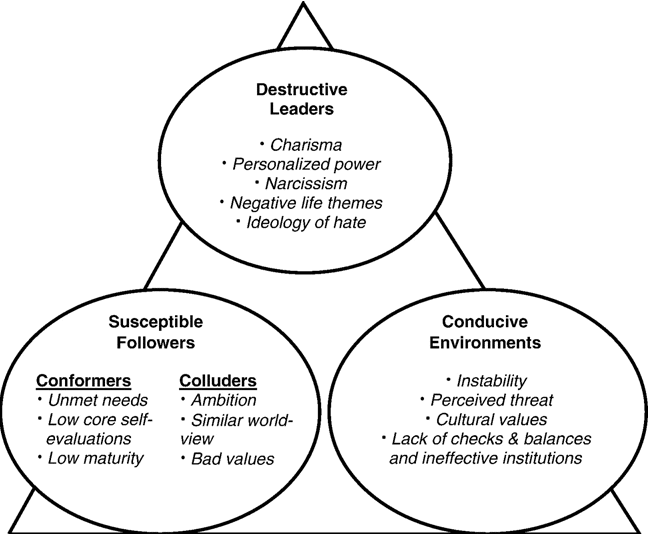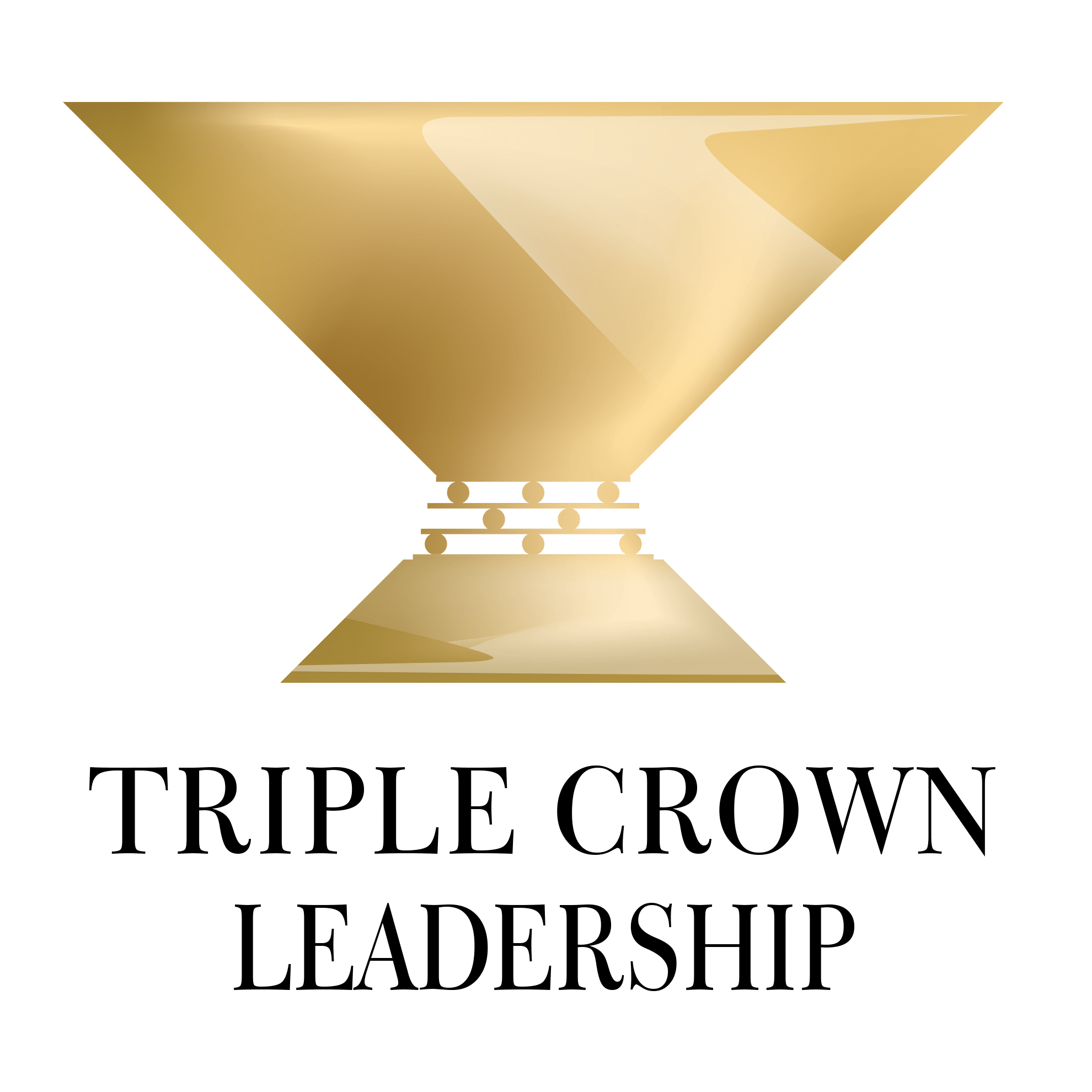Article Summary:
We have too many toxic leaders in our workplaces, communities, and nations. What are their characteristics? Why do so many people follow them willingly? What makes an environment conducive for them to capture and maintain power? By Gregg Vanourek.
+++
As if things weren’t hard enough in our lives, we’re also beset with more than our fair share of toxic leaders.
Toxic leaders, according to Jean Lipman-Blumen of Claremont Graduate University and author of The Allure of Toxic Leaders, are:
“those individuals who, by virtue of their destructive behaviors and their dysfunctional personal qualities or characteristics, inflict serious and enduring harm on the individuals, groups, organizations, communities and even the nations that they lead.”
Part of the toxic leader’s game plan, she notes, is to fashion a “grand illusion… a grandiose dream of an unrealistic future” that’s “unconditionally positive.” Meanwhile, the toxic leader is the “omnipotent savior,” and followers become unquestioning, fiercely loyal, dismissive of other options, and sometimes infatuated.
Toxic leaders come in various shapes and sizes. What’s more, people have widely varying views about them: “my toxic leader may appear to be your ideal leader,” she notes. (1)
Signs of Toxic Leadership
The signs of toxic leadership include:
- leaders using their position for their own personal ends
- playing to people’s fears
- violating people’s rights
- leaving their followers worse off
- not caring about the consequences of their actions
- lacking integrity
- being self-absorbed and arrogant
- having exorbitant ambition
Toxic leaders, according to the research, engage in narcissistic, self-promoting, and erratic behavior. To which we can add hubris, bullying, harassment, and exploitation.
Toxic leaders can manipulate our minds and leverage social dynamics that place us at risk of their exploits. Examples abound of toxic leaders successfully creating the conditions in which they can get good people to lower or abandon their standards and support things they would otherwise find unappealing or even abhorrent—in some cases without even realizing it. We see this in cutthroat corporate environments, fanatical sports franchises, street gangs, drug cartels, abusive religious organizations, cults, political movements, and nations filled with good people who tolerate or support destructive leaders.

Leadership Derailers Assessment
Take this assessment to identify what’s inhibiting your leadership effectiveness. It will help you develop self-awareness and identify ways to improve your leadership.
The Toxic Triangle
This brings us to the “toxic triangle,” a cruel confluence of destructive leaders, susceptible followers, and conducive environments that allow for truly bizarre and harmful events to unfold. (Source: Art Padilla, Robert Hogan, and Robert B. Kaiser, “The Toxic Triangle.”) (2) See the image below.

We address each of these three factors and their components in turn.
I. Destructive Leaders
Destructive leaders tend to have charisma, a personalized need for power, narcissistic tendencies, a difficult life history, and an extreme ideology.
Charisma. Leaders are more pernicious when they have charisma and use it for nefarious purposes. They have strong presentation skills (and carefully curated personal branding), impressive energy levels, and effective salesmanship of their vision.
Personalized Need for Power. These leaders use power for their own self-promotion and personal gain, not to serve others. They’re consumed with self-aggrandizement and can be irresponsible, impulsive, dishonest, manipulative, and punitive, according to the research.
Narcissism. Narcissistic leaders have an inflated sense of self-importance, almost inexhaustible need for admiration, inability to handle criticism, lack of empathy and concern for others, and sense of entitlement. They tend to be self-absorbed and attention-seeking. Also, they disregard other people’s viewpoints and ignore their welfare, perhaps also exploiting them. They demand total loyalty and obedience, claim special knowledge and privilege, and offer grand visions that often never come to fruition. Their promises are unrealistic, even utopian. They insist that they alone can save and protect us and give us the security and reassurance we seek when things are topsy-turvy.
Negative Life Themes. Destructive leaders often suffered from childhood adversity, distress, or trauma. They may have experienced feelings of neglect, abandonment, worthlessness, or powerlessness. Sometimes, they’ve been traumatized or otherwise damaged and haven’t been able to heal or move forward.
Extreme Ideology. These leaders have a worldview that’s cynical or even hateful. They think and speak not in terms of lifting people up but in terms of conquering rivals and crushing enemies, of fear and danger.
If these are the characteristics of destructive leaders, what makes people susceptible to following and supporting them? After all, toxic leaders wouldn’t be so problematic if nobody followed them.

Personal Values Exercise
Complete this exercise to identify your personal values. It will help you develop self-awareness, including clarity about what’s most important to you in life and work, and serve as a safe harbor for you to return to when things are tough.
II. Susceptible Followers
Destructive leaders, according to the research (2), have two types of followers: conformers and colluders.
- Conformers “passively allow bad leaders to assume power” because of their unmet needs and other characteristics that make them vulnerable.
- Colluders “seek personal gain through association with a destructive leader.” They’re ambitious and will often imitate the toxic leader’s behavior, placing them in the power circle and setting themselves up to become toxic leaders themselves if possible.
Unmet Needs. Some followers are susceptible to destructive leaders because they’re financially or emotionally insecure. They may have trouble putting food on the table. Or they feel unsafe, lonely, isolated, empty, or alienated from society.
Lower Core Self-Evaluations. Often, followers are susceptible to destructive leaders because they have lower self-esteem or an “external locus of control” (the belief that external factors, such as luck or others’ actions, drive their station in life rather than their own efforts). According to researchers, people with low self-esteem are more likely to follow charismatic leaders.
Psychological Factors. Given their ego development and self-concept, some people are more likely to follow rules and conform to authority (even to the point of harming others in the name of authority or loyalty). They may be avoidant and have a hard time accepting criticism and controlling their impulses. Also, they may seek attention and be emotionally reactive or have some narcissistic traits. Impressionable followers may internalize the leader’s dark ideology and buy into grand promises. (3)
Another factor, as noted above, is rationalization. People can emotionally identify with a leader because of various factors (e.g., shared worldview, financial interest, policy agreement) and then conceptually rationalize their way into overlooking or excusing their outrageous or even vile behavior.
“I could stand in the middle of Fifth Avenue and shoot somebody, and I wouldn’t lose any voters, OK?
It’s, like, incredible.”
-Donald Trump at an Iowa campaign event in January 2016
Distinct from the conformers who go along with destructive leaders are colluders who seek to gain by actively supporting them.
Ambition. Colluders are often hungry for status, and they’re willing to exploit people in service of pleasing their dear leader and setting themselves up for more wealth, power, and status.
Similar Worldview. Colluders follow such leaders because their values and beliefs are congruent with them. The closer the worldview, the stronger the bond.
Harmful Values. Colluding followers are more prone to selfishness, egotism, or greed. They may be impulsive or aggressive.

Alignment Scorecard
When organizations aren’t aligned, it can reduce performance dramatically and cause frustration and dysfunction. With this Alignment Scorecard, you can assess your organization’s level of alignment and make plans for improving it.
III. Conducive Environment
There’s one more factor destructive leaders need in addition to susceptible followers in this toxic triangle: a conducive environment. It’s a context of instability, perceived threat, certain cultural values, and missing guard-rails.
Instability. Destructive leaders exploit instability. They promise bold change to restore peace and order, in the process enhancing their power. In unstable circumstances, followers are more likely to accept that bold, decisive action is required by the leader to restore order. Followers go along with fast, unilateral decisions. They give away their power.
Perceived Threat. Destructive leaders tap into followers’ feelings of danger, grievance, or mistreatment. They exploit feelings of desperation. When things are declining or falling apart, leaders who promise us a safe and better world can be alluring. “When people feel threatened,” write Padilla, Robert, and Kaiser, “they are more willing to accept assertive leadership.”
Essentially, toxic leaders are exploiting the common human tendency to turn outsiders into enemies. We humans are tribal, and our brains are remarkably good at rationalizing the choices of our tribe and our leaders. We often do this unconsciously, making it tricky to guard against. Meanwhile, focusing on enemies is an exceptionally effective way to create cohesion within the tribe.
Notably, the threat may not even be real. Destructive leaders can create and perpetuate the perception of a threat or an enemy to strengthen their power. The mechanisms here are fear and blame, sometimes fueled by deception.
“Fear is the most powerful human emotion…. Toxic leaders will blame broad groups of people such as migrants or religious groups for the challenges faced by society and seek to exploit the momentum that follows it. It is the perception of a threat that creates the environment for the toxic leader to thrive. The threat does not have to be real.”
–Roderic Yapp, “The Toxic Triangle—The Environment and Followers of Toxic Leaders”
Cultural Values. Destructive leaders can magnify their power when certain values are prevalent in the culture. In particular, it works better in cultures with an avoidance of uncertainty and a large power distance (e.g., large disparities in security, education, and wealth). Leaders provide rules, rituals, and structure to take advantage of this situation.
Missing Guard-Rails. Destructive leaders are able to capture, enhance, and maintain their authority in environments where the concentration of power is possible. This includes centralized governance systems that rely on top executives for decisions. In such environments, these leaders will seek to tighten their control and eliminate rivals. To do so, they will seek to manipulate public opinion with lies, propaganda, or negative campaigning (which is so effective because people assign greater weight to negative information than positive information).
“Perhaps the most important environmental factor for preventing destructive leadership is the presence of checks and balances.” -Art Padilla, Robert Hogan, and Robert B. Kaiser, “The Toxic Triangle”
Conclusion
There are several factors at work in the toxic triangle, leading to alarming results. Given these dynamics, important questions arise:
What kind of leaders do we want and need—those animated by service and love or self-aggrandizement and fear?
Don’t we want excellent and ethical leaders who can sustain great results with integrity over time (what we call “triple crown leaders”)?
Do we want leaders who serve the larger good—leaders we can admire, who make us better?
What kind of followers, workers, and citizens do we need to be?
What kind of world do we want for ourselves and future generations—and what are we willing to do about it?
Tools for You
- Leadership Derailers Assessment to help you identify what’s inhibiting your leadership effectiveness
- Personal Values Exercise to help you determine and clarify what’s most important to you
- Alignment Scorecard to help you assess your organization’s level of alignment

Leadership Derailers Assessment
Take this assessment to identify what’s inhibiting your leadership effectiveness. It will help you develop self-awareness and identify ways to improve your leadership.
Related Articles & Books
- “Why People Fall for Toxic Leaders”
- “The Problem of Bad Leaders—And Why We Keep Following Them”
- “BAD Leadership: 7 Types”
- “What Followers Can Do about Bad Leaders”
- “The Trump Leadership Playbook–And Why It Matters”
- “The Importance of Integrity in Leadership”
- “The Root Causes of Ethical Failings (and Our Political Dysfunction)”
- “Are You Working for an Unethical Organization?”
- “What to Do If You Work for an Unethical Organization”
- “What to Do If You Work for a Toxic Boss”
- “The Importance of Credibility in Leadership”
- “The Case for Love-Based Leadership”
- “The Essential Qualities of Servant Leadership”
- “Why Are We Talking about Ethics?”
- Jean Lipman-Blumen, “Toxic Leadership: When Grand Illusions Masquerade as Noble Visions,” Leader to Leader, Spring 2005.
- Art Padilla, Robert Hogan, Robert B. Kaiser. “The toxic triangle: Destructive leaders, susceptible followers, and conducive environments,” The Leadership Quarterly 18 (2007) 176–194.
- Jean Lipman-Blumen, The Allure of Toxic Leaders (Oxford University Press, 2005).
- Barbara Kellerman, Bad Leadership (Harvard Business School Press, 2004).
- Ira Chaleff, To Stop a Tyrant: The Power of Political Followers (Greenleaf Book Group, 2024).
Postscript: Quotations on Toxic Leaders and Susceptible Followers
- “…strong yearnings for toxic leaders percolate up from our unconscious, where psychological needs send us in search of authority figures who can offer us comfort and promise to satisfy some of our deepest longings.” -Jean Lipman-Blumen
- “Integrity is the most important characteristic of a leader, and one that he or she must be prepared to demonstrate again and again.” -Warren Bennis, leadership author
- “Ultimately, an organization cannot be excellent without being ethical…. There is… one hard and fast rule: triple crown leaders do not compromise on the ethical imperative. Once they do so, they have stepped onto a slippery slope. Ethical compromises set a bad precedent, communicate a reverberating message, undermine credibility, and will likely come back to haunt them many times over. Leaders have to draw the line. Better to fail with honor than succeed with disgrace.” -Bob and Gregg Vanourek, Triple Crown Leadership: Building Excellent, Ethical, and Enduring Organizations
- “Do your homework…. investigate the toxic leader’s history. Did that individual leave a toxic trail in previous leadership positions?” -Jean Lipman-Blumen, “The Allure of Toxic Leaders: Why Followers Rarely Escape Their Clutches,” Ivey Business Journal, January/February 2005
- “He who passively accepts evil is as much involved in it as he who helps to perpetrate it. He who accepts evil without protesting against it is really cooperating with it.” -Dr. Martin Luther King, Jr.
- “If I had to reduce the responsibilities of a good follower to a single rule, it would be to speak truth to power.” -Warren Bennis
- “The words ‘leader’ and ‘follower’ bring to mind a common script in which the leader is in charge, saying, ‘You do this, and you do that.’ Meanwhile, followers are imagined as inferior beings in need of the leader’s direction. We need to rethink this outdated script…. Followers have to keep leaders and peers ethically and legally in check. Instead of viewing followers as the ‘good soldiers’ who carry out commands dutifully, we need to view followers as the primary defenders against toxic leaders or dysfunctional organizations…. Followers cannot abdicate their courageous conscience by outsourcing it to the leader.” -Robert E. Kelley, “Rethinking Followership” in Riggio, Chaleff, and Lipman-Blumen, The Art of Followership (Jossey-Bass, 2008).
- “If you lie down with dogs, you will get up with fleas.” -English proverb
- “People bind themselves into political teams that share moral narratives. Once they accept a particular narrative, they become blind to alternative moral worlds…. If you think about moral reasoning as a skill we humans evolved to further our social agendas—to justify our own actions and to defend the teams we belong to—then things will make a lot more sense.” -Jonathan Haidt, The Righteous Mind: Why Good People Are Divided by Politics and Religion
Sources
(1) Barbara Kellerman, Fellow at the Center for Public Leadership at Harvard Kennedy School and author of Bad Leadership, has noted that even some of the worst leaders have often brought some value to their followers.
(2) Source: Art Padilla, Robert Hogan, Robert B. Kaiser. “The toxic triangle: Destructive leaders, susceptible followers, and conducive environments,” The Leadership Quarterly 18 (2007) 176–194. They identified five features of destructive leadership: “Destructive leadership is seldom absolutely or entirely destructive: there are both good and bad results in most leadership situations… destructive leadership involves dominance, coercion, and manipulation rather than influence, persuasion, and commitment… destructive leadership has a selfish orientation; it is focused more on the leader’s needs than the needs of the larger social group. The effects of destructive leadership are outcomes that compromise the quality of life for constituents and detract from the organization’s main purposes. Destructive organizational outcomes are not exclusively the result of destructive leaders, but are also products of susceptible followers and conducive environments.”
(3) According to researchers, the psychological factors of followers that can foster dysfunctional leadership include a need for reassuring authority figures, the need for security and certainty, a need to feel chosen or special, the desire for membership in a community, or a fear of isolation, ostracism, or “social death.” (Source: M. Uhl-Bien et al., “Followership Theory: A Review and Research Agenda,” The Leadership Quarterly, 25, p. 98.)

Triple Crown Leadership Newsletter
Join our community. Sign up now and get our monthly inspirations (new articles, announcements, opportunities, resources, and more). Welcome!
+++++++++++++++++++++++
This article is by Gregg Vanourek, a writer, teacher, and TEDx speaker on leadership and personal development. He is co-author of three books, including Triple Crown Leadership: Building Excellent, Ethical, and Enduring Organizations (a winner of the International Book Awards written with his father, Bob Vanourek). Check out their Leadership Derailers Assessment or get their monthly newsletter. If you found value in this, please forward it to a friend. Every little bit helps!


